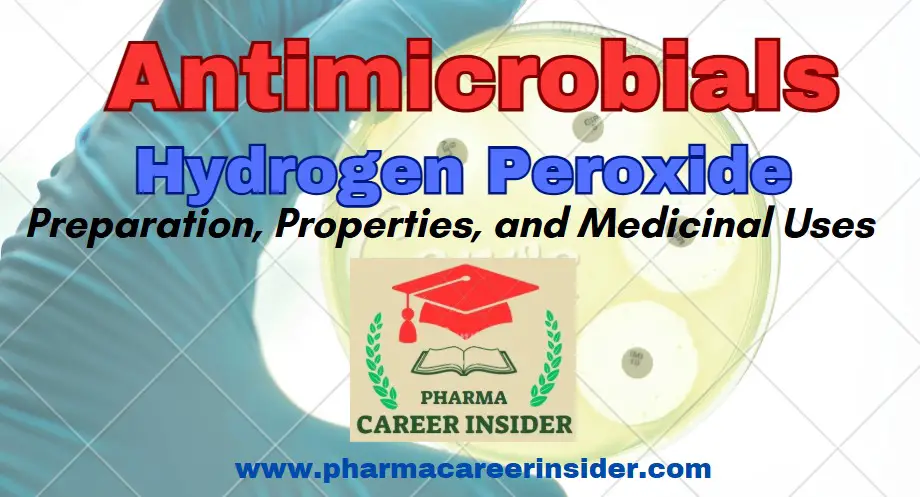Meta Description
Learn about hydrogen peroxide (H₂O₂), its preparation, properties, medicinal uses, and safety precautions. Discover how it is used in wound care, oral hygiene, earwax removal, and medical sterilization.
Introduction
Hydrogen peroxide (H₂O₂) is a colorless, odorless liquid known for its strong oxidizing and disinfecting properties. It is widely used as an antiseptic, wound cleanser, bleaching agent, and disinfectant in medical, household, and industrial applications. Hydrogen peroxide is commonly found in first-aid kits, mouthwashes, and water treatment solutions due to its ability to kill bacteria, fungi, and viruses by releasing oxygen upon decomposition.
This article explores the preparation, properties, medicinal uses, and safety precautions of hydrogen peroxide.
Preparation of Hydrogen Peroxide
Hydrogen peroxide is produced through several chemical processes, with the Anthraquinone Process being the most common industrial method.
1. Industrial Preparation (Anthraquinone Process)
This process involves the auto-oxidation of anthraquinone using hydrogen and oxygen in the presence of a catalyst.

The hydrogen peroxide is then extracted, purified, and stabilized for commercial use.
2. Laboratory Preparation
Hydrogen peroxide can be prepared in the lab by reacting barium peroxide (BaO₂) with sulfuric acid (H₂SO₄).

This method produces dilute hydrogen peroxide solutions, which can be further concentrated through vacuum distillation.
Properties of Hydrogen Peroxide
Chemical Formula: H₂O₂
Molecular Weight: 34.01 g/mol
Appearance: Colorless, slightly viscous liquid
Odor: Slightly sharp, similar to ozone
Solubility: Completely soluble in water, alcohol, and ether
pH: Slightly acidic (pH ~4.5–5.5)
Stability: Decomposes into water and oxygen upon exposure to light or heat
Oxidizing Ability: Strong oxidizer, used as a disinfectant and bleaching agent
Hydrogen peroxide decomposes naturally into water and oxygen, making it an environmentally friendly antiseptic and cleaner.

Medicinal Uses of Hydrogen Peroxide
1. Antiseptic and Wound Disinfectant: Used in first aid to clean cuts, scrapes, and wounds, preventing bacterial infections. Releases oxygen bubbles, which help remove debris and dead tissue.
2. Oral Care and Mouthwash: Found in medicated mouthwashes to treat oral ulcers, gingivitis, and bad breath. Diluted solutions (3%) help whiten teeth and reduce bacterial growth.
3. Earwax Removal: Used in ear drops to soften and dissolve earwax buildup. Bubbles formed by oxygen release help break down hardened wax.
4. Skin Care and Acne Treatment: Applied topically to acne-prone skin to kill bacteria and dry out pimples.Used in diluted form (1–3%) to prevent skin irritation.
5. Disinfectant for Medical Equipment: Hydrogen peroxide vapor is used to sterilize surgical instruments and hospital surfaces. Kills bacteria, fungi, and viruses, making it effective against drug-resistant pathogens.
Other Applications of Hydrogen Peroxide
- – Household Cleaner: Used to sanitize kitchen surfaces, floors, and bathrooms.
- – Laundry Bleach: Whitens clothes and removes stains.
- – Food Industry: Used in food packaging and milk pasteurization as a disinfectant.
- – Water Treatment: Used to purify drinking water and eliminate bacteria.
- – Agriculture: Prevents fungal growth on plants and seeds.
Side Effects and Precautions
While hydrogen peroxide is safe in diluted forms, improper use or exposure to high concentrations can cause:
- Skin and Eye Irritation: Higher concentrations can cause burns, redness, and irritation.
- Oral Mucosa Damage: Undiluted hydrogen peroxide can cause mouth and throat burns.
- Gastrointestinal Toxicity: Swallowing concentrated hydrogen peroxide can cause nausea, vomiting, and internal bleeding.
- Respiratory Issues: Inhalation of vapors from industrial hydrogen peroxide can cause lung irritation.
Precaution: Always use diluted solutions (3% for medical use, 0.5–1% for oral care) and avoid contact with eyes or ingestion.
Conclusion
Hydrogen peroxide (H₂O₂) is a versatile antiseptic, disinfectant, and oxidizing agent used in medicine, oral care, wound treatment, and water purification. Its ability to kill bacteria, viruses, and fungi makes it a valuable tool in healthcare and household applications. However, proper dilution and handling are essential to prevent irritation and toxicity.
Frequently Asked Questions (FAQs)
1. Can hydrogen peroxide be used on wounds?
Answer: Yes, 3% hydrogen peroxide is commonly used to clean wounds by killing bacteria and removing debris. However, excessive use may delay healing.
2. Is hydrogen peroxide safe for oral care?
Answer: Yes, but only in diluted form (0.5–1%). It helps whiten teeth and reduce bacteria, but higher concentrations can damage gums and enamel.
3. Can hydrogen peroxide be used for earwax removal?
Answer: Yes, a few drops of 3% hydrogen peroxide in the ear help soften and dissolve excess wax.
4. What happens if you swallow hydrogen peroxide?
Answer: Swallowing small amounts of diluted hydrogen peroxide may cause mild irritation, while higher concentrations can cause severe internal burns and poisoning.
5. How does hydrogen peroxide kill bacteria?
Answer: Hydrogen peroxide releases oxygen, which disrupts bacterial cell membranes and proteins, effectively killing microorganisms.




